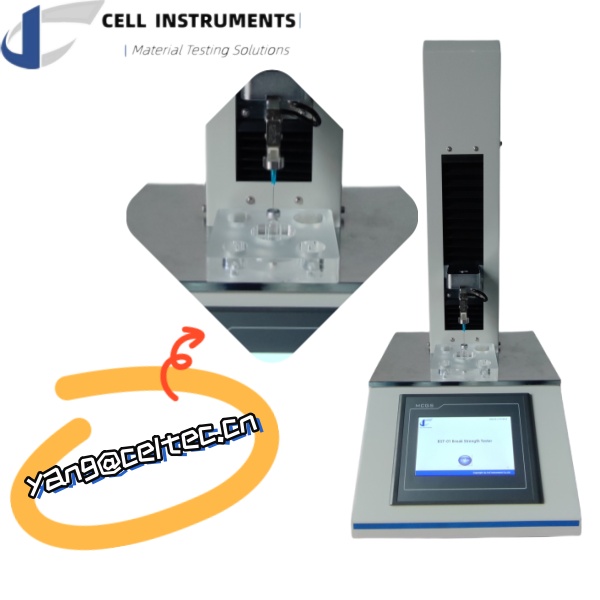Needle Penetration Test for Vial Stopper Quality Assurance
I. What is Needle Penetration Testing?
Definition and Purpose
Needle penetration testing is a crucial method used to assess the puncture resistance of vial stoppers and the puncture ability of needles. This test ensures that the materials used in medical and pharmaceutical packaging maintain their integrity when penetrated by needles, thereby guaranteeing safety and effectiveness.
Standards and Guidelines
This test is governed by stringent standards such as ISO 8871-5 and USP 381. These standards outline the procedures and criteria for testing to ensure consistency and reliability. ISO 8871-5 specifically details the requirements for elastomeric parts used in parenterals and for devices for medical use, while USP 381 addresses the quality attributes of elastomeric closures for injections.
II. Introduction
Overview of Vial Stopper Quality Assurance
Vial stoppers play a vital role in the pharmaceutical and medical industries by protecting the contents of vials from contamination and ensuring sterility. Rigorous testing is essential to confirm that these stoppers can withstand the stress of needle penetration without compromising their integrity.
Importance of Vial Stoppers
In the pharmaceutical and medical sectors, maintaining the sterility and integrity of vial contents is paramount. Stoppers must be puncture-resistant to prevent contamination and leakage, which could affect drug efficacy and patient safety. Therefore, rigorous quality assurance measures, including needle penetration testing, are necessary.
III. Importance of Needle Penetration Testing in Vial Stopper Quality Assurance
Ensuring Sterility and Integrity
Needle penetration testing is critical in preventing contamination and leakage. By ensuring that vial stoppers can withstand needle penetration, we can maintain the sterility of the vial’s contents and ensure the safety and efficacy of the drug.
Regulatory Compliance
Compliance with standards such as ISO 8871-5 and USP 381 is mandatory for the approval and marketability of pharmaceutical products. Penetrability testing helps meet these regulatory requirements, thereby facilitating the approval process for new products.
New Product Research and Development
Needle penetration testing plays a crucial role in the research and development of new products. By evaluating the performance of new materials and designs under realistic conditions, manufacturers can ensure their products meet the highest standards of quality and safety.
IV. Testing Procedures and Methodologies
Sample Preparation
Proper sample preparation is essential for accurate needle penetration testing. This involves selecting appropriate vial stoppers and needles and preparing them according to the test standards.
Testing Equipment

Cell Instruments offers advanced testing equipment such as the NPT-01 Penetrability Tester. This device is designed to accurately measure the force required to penetrate vial stoppers, providing reliable data for quality assurance. The NPT-01 features automated testing capabilities, precise force measurement, and easy-to-use software for data analysis.
Test Execution
Conducting the penetrability test involves several steps:
- Preparing the sample and setting up the NPT-01 Penetrability Tester.
- Inserting the needle into the vial stopper and recording the penetration force.
- Repeating the test with multiple samples to ensure consistency.
V. Analysis and Interpretation of Results
Data Collection and Analysis
During the test, the force required to penetrate the vial stopper is recorded. This data is then analyzed to assess the puncture resistance of the stopper and the performance of the needle.
Common Issues and Solutions
Common issues include inconsistent results due to improper sample preparation or equipment calibration. These can be addressed by following standardized procedures and regularly maintaining the testing equipment.
Criteria for Pass/Fail
Benchmarks for pass/fail criteria are established based on ISO 8871-5 and USP 381. These criteria ensure that only vial stoppers meeting the highest standards of puncture resistance are approved for use.
VI. Applications and Benefits of Needle Penetration Testing
Applications Across Industries
Needle penetration testing is used in various industries, including pharmaceuticals, medical devices, and packaging. It ensures that materials used in these industries can withstand the rigors of needle penetration without compromising their integrity.
Quality Assurance and Product Development
By providing reliable data on puncture resistance, penetrability testing enhances product reliability and builds customer trust. It also plays a crucial role in research and development, helping manufacturers develop new products that meet the highest standards of quality and safety.
VII. Custom Solutions and Advanced Testing Capabilities
Customization and Automation
Cell Instruments offers customized testing solutions to meet specific client needs. Our NPT-01 Penetrability Tester can be tailored to test various types of vial stoppers and needles. Additionally, automation enhances testing efficiency and accuracy, reducing the time and effort required for manual testing.
VIII. FAQ
Q1: What is the purpose of needle penetration testing?
A1: Penetrability testing assesses the puncture resistance of vial stoppers and the puncture ability of needles to ensure product integrity and safety.
Q2: Which standards govern needle penetration testing?
A2: Penetrability testing is governed by ISO 8871-5 and USP 381, which outline the procedures and criteria for testing.
Q3: Why is regulatory compliance important in needle penetration testing?
A3: Regulatory compliance ensures that products meet industry standards, facilitating approval and marketability while ensuring safety and efficacy.
Q4: What equipment is recommended for penetrability testing?
A4: The NPT-01 Penetrability Tester from Cell Instruments is recommended for its precision, automation capabilities, and reliable data output.
Q5: How can common issues in penetrability testing be addressed?
A5: Common issues can be addressed by following standardized procedures, ensuring proper sample preparation, and regularly maintaining the testing equipment.
Further Reading
Needle Penetration Test Equipment
Needle Puncture Resistance Testing

